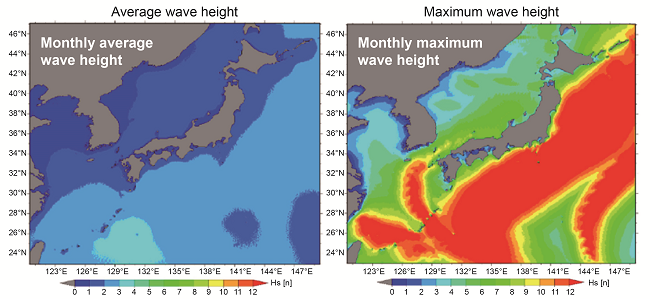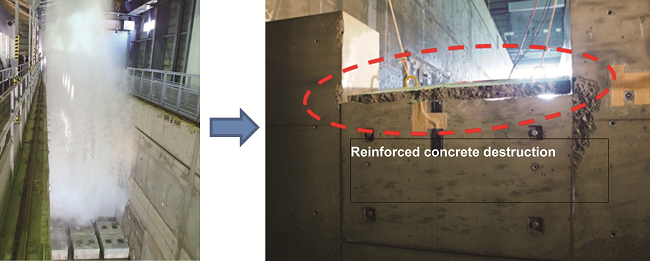Experiment of wave force acting on parapets
Major Research 1C Research on Mitigation and Restoration of Storm Surge and Wave Disasters
Background and Objectives
Since the Ise Bay Typhoon struck in September 1959, there have been no devastating storm surge and wave disasters in Japan. However, the U.S. suffered severe damages due to Hurricane Katrina in September 2005, and so did the Philippines due to Typhoon Haiyan in November 2013. In future, global warming might bring higher storm surges and waves than those we have expected in Japan.
Therefore, this research is aimed for changing disaster prevention and mitigation measures into a pre-disaster stage from post-disaster one and focuses on how to mitigate damage by the maximum storm surge and wave conditions and how to rapidly recover and reconstruct after the damage has occurred. Therefore, we conduct research to encourage hard and soft measures. Specifically, we will develop a numerical model to estimate the maximum storm surge and wave and their damage and will also develop design methods to build robust structures.
Research topics
Research and development comprises the following two subthemes:
1.Research on storm surge, wave and maximum damage estimation
We will develop the following to determine the characteristics of the damage due to the maximum storm surge and wave: an accurate storm surge prediction model, which incorporates a weather model; and a new method based on a 3-D fluid model to simulate tidal levels and flows at the time of storm surge. Also, we will employ a high statistical analysis to estimate the effects of global warming on the maximum storm surge and wave and long-term variations in these statistics. In addition, we will establish a calculation technique to estimate the following wave transformations: the wave sheltering effects of breakwaters damaged through sliding, depression and others; and overtopping prevention effects of seawall having collapsed parapet, dispersed wave-dissipating blocks and other damages.
2.Research on the technology to reduce maximum storm surge and wave disasters
We will elucidate structural stability under complex conditions in which unexpectedly high water level due to storm surge coincides with high waves. In addition, we will investigate methods of estimating the damage on structures due to storm surge and waves and countermeasure against such damages, and develop a method to design robust structures.
Activities in FY 2017
In the elucidation of oceanographic phenomenon based on central processing and analysis of observation data, we summarized the statistical analysis of the wave observation data in 2016 from the Nationwide Ocean Wave Information Network for Ports and Harbours into an annual report. Also, we analyzed a tsunami in 2016; moreover, we improved the accuracy of wave data processing.
In the study of seasonal and regional statistics on swell observed in Japanese coast, we referred to observational wind data to identify wind waves and swells under the wave directional spectrum and then validated the argument that wind waves generally conform to the relation between the wave steepness and the wave directional spreading, which was proposed by Goda, et al., however, swells do not conform.
In the development of a harbor tranquility analysis method for local wind waves and ship waves in a harbor, we modified our ship wave generation model, in which the locations and courses of ships can be freely set on 2-D calculation grids, with drawing an estimation chart of coefficients to adjust the ship wave heights which vary depending on the grid intervals and water depth. With this chart, the coefficients can be applied to intended ship specifications, such as ship length, width and draft; therefore, the model is expected to be applied for practical works such as an investigation on the effect of ship waves on harbor tranquility.
In the proposal for improvement of prediction accuracy of swell, we estimated ocean waves around Japan for 3 years by WW3 model with 4 types of switches for energy transfer from wind to wave, energy dissipation and other phenomena. As a result, we found that differences develop in wave statistics including the annual average significant wave height.

Wave statistics estimated by wave model WW3 with switch ST4
In the estimation of wave transformation around damaged structures to evaluate remaining performance for sheltering, we chose submerged breakwater with rectangle and trapezoid cross-sections to conduct model experiments on the wave height transmission rate and the periodic-modulation rate. On impermeable cross sections, we found wave conditions for periodic shortening associated with wave dispersion before breaking which markedly reduce wave height transmission rates. We confirmed that wave transformation with trapezoid cross sections can be reproduced by using the existing Boussinesq model. Proper evaluation of port calmness at the time of breakwater damage is expected to be performed using the above-mentioned conditions.
In the development of the maritime and environmental simulation model using mesoscale weather forecasting model, we used atmospheric pressure and wind predicted by WRF and the Japan Meteorological Agency's prediction MSM to calculate the storm surge caused by Typhoon Choi-wan in 2015 in Nemuro and obtained good reproducible results. We used the Isewan simulator, which incorporates GPV, GSMJP and WRF, to predict short-term environmental change.
In the study on the wave force, overtopping and overflow of wind waves on tsunamis and storm surges over design water level, we elucidated mound transmitted wave force acting on the backside of seawall and inundation from the mound into the hinterland through hydraulic experiments. Also, we developed a simple method of estimating overtopping and overflowing rate of the seawall. In addition, we studied the characteristics of wave force acting on parapets in the case of wind waves, solitary waves and wind waves with overflow and overtopping. Then, we classified the wave breakers into breakers under overflow influence, Bagnold-type and Wagner-type and investigated the destruction processes of reinforced concrete.




